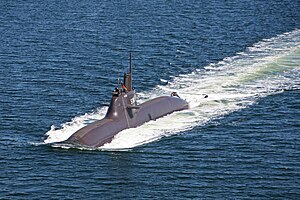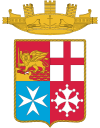
The Dolphin class is a diesel-electric submarine developed in Israel and constructed by Howaldtswerke-Deutsche Werft (HDW) in Kiel, Germany, for the Israeli Navy. The first boats of the class were based on the export-only German 209-class submarines, but modified and enlarged. The Dolphin 1 sub-class is slightly larger than the German Navy Type 212 in length and displacement. The three newer air-independent propulsion (AIP) equipped boats are similar to the Type 212 vessels in underwater endurance, but are 12 metres (39 ft) longer, nearly 500 tonnes heavier in submerged displacement and have a larger crew than either the Type 212 or the Type 214.
Air-independent propulsion (AIP), or air-independent power, is any marine propulsion technology that allows a non-nuclear submarine to operate without access to atmospheric oxygen. AIP can augment or replace the diesel-electric propulsion system of non-nuclear vessels.

Howaldtswerke-Deutsche Werft is a German shipbuilding company, headquartered in Kiel. It is part of the ThyssenKrupp Marine Systems (TKMS) group, owned by ThyssenKrupp. The Howaldtswerke shipyard was founded in Kiel in 1838 and merged with Hamburg-based Deutsche Werft to form Howaldtswerke-Deutsche Werft (HDW) in 1968. The company's shipyard was formerly used by Friedrich Krupp Germaniawerft until the end of World War II.
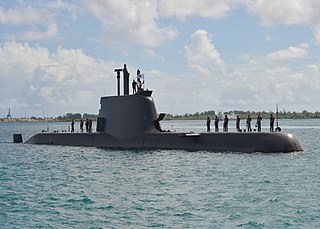
The Type 214 is a class of diesel-electric submarines developed exclusively for export by Howaldtswerke-Deutsche Werft GmbH (HDW). It features diesel propulsion with an air-independent propulsion (AIP) system using Siemens polymer electrolyte membrane (PEM) hydrogen fuel cells. The class combines the design principles of the Type 209 submarine family and the features of the Type 212A submarine. However, as an export design, it lacks some of the classified technologies of the Type 212 such as the non-magnetic steel hull that makes it difficult to detect using a magnetic anomaly detector.

The Scorpène-class submarines are a class of diesel-electric attack submarines jointly developed by the French Naval Group and the Spanish company Navantia. It features diesel propulsion and an additional air-independent propulsion (AIP). It is now marketed as the Scorpène 2000.
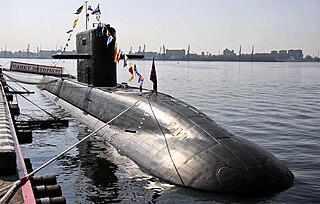
Lada class, Russian designation Project 677 Lada is the new advanced class of diesel-electric attack submarine designed by the Russian Rubin Design Bureau. A program to develop a "fourth generation" diesel-electric submarine, it aimed to produce a highly improved version of the Project 636 with better acoustic signature, new combat systems and possibly air-independent propulsion. However, in 2019, Alexander Buzakov, the head of the Admiralty Shipyard, indicated that there were no plans to equip the Lada class with an air-independent propulsion system. In July 2022 it was reported that work on an electrochemical generator to produce hydrogen from diesel fuel and oxygen was continuing and that the Rubin Central Design Bureau signed a new contract in 2019 to continue work. This was scheduled to be completed by the mid-2020s. In 2023, the decision was taken to decommission and scrap the lead ship of the class, the Sankt Peterburg due to the very high costs of modernising the submarine.
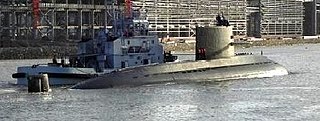
The Type 039A submarine is a class of diesel-electric submarine in China's People's Liberation Army Navy. It is China's first AIP powered submarine and presumed to be one of the quietest diesel-electric submarine classes in service. This class is the successor of the Type 039 submarine. The official Chinese designation is 039A as the ship is based on the 039 class, but as the 039A has very little resemblance to the 039 it is commonly referred to as the Type 041. The class is designed to replace the aging Type 033 and the older Type 035 submarines that previously formed the backbone of the conventional submarine force.

The Nazario Sauro class are diesel-electric submarines operated by the Italian Navy. All boats were built by Fincantieri in Monfalcone.
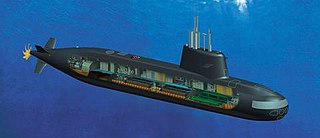
The S1000-class submarine was a joint development by Russia and Italy, said to be an advanced version of the Amur-class submarine. The joint development was between Rubin Design Bureau of Russia and Fincantieri of Italy. The project was suspended in 2014.

IDAS is a medium-range missile currently being developed for the Type 209 and Type 212A submarine class of the German Navy.

The Sōryū-class submarines (16SS) are diesel-electric attack submarines. The first boat in the class entered service with the Japan Maritime Self-Defense Force in 2009. The design is an evolution of the Oyashio-class submarine, from which it can most easily be distinguished by its X-shaped stern combination diving planes and rudders. The Sōryūs have the largest displacement of any submarine used by post-war Japan.

The Type 209 is a range of diesel-electric attack submarines developed exclusively for export by Howaldtswerke-Deutsche Werft of Germany. Five class variants, including modifications thereof, have been successfully exported to 15 countries, with 68 submarines being built and commissioned to five different variants between 1971 and 2021. More boats have been built to modified designs.
The Blekinge-class submarine is the next generation of submarines developed by Kockums for the Swedish Navy, also known as the A26 type.
The Type 216 is a submarine design concept announced by Howaldtswerke-Deutsche Werft based on the Type 212/214.
The Invincible-class submarines, formally classified as the Type 218SG submarines, is a class of conventionally-powered attack submarines, ordered by the Republic of Singapore Navy (RSN) from German-based naval conglomerate ThyssenKrupp Marine Systems (TKMS). The Type 218SG is an extensively-customised derivative of the export-oriented Type 214 submarine, with specific design characteristics drawn from Type 212 submarines. They feature several capabilities, including a substantial level of automation, a significant payload capacity, enhanced underwater endurance and superlative ergonomics.

The KSS-III or Dosan Ahn Changho-class is a series of diesel-electric attack submarines currently being built for the Republic of Korea Navy (ROKN), jointly by Hanwha Ocean and HD Hyundai Heavy Industries (HHI). The KSS-III is the final phase of the Korean Attack Submarine program, a three-phased program to build 27 attack submarines for the ROKN, between 1994–2029.

The Taigei-class submarines (29SS) (Japanese: たいげい, "Big Whale") is a new class of attack submarines after 2022, developed for the Japan Maritime Self-Defense Force. It is the successor to the Sōryū class.
The Type 212CD class is a submarine class developed by ThyssenKrupp Marine Systems (TKMS) for the Norwegian and German navies. The class is derived from the Type 212 submarine class, but will be significantly larger than the 212 class.
The Dakar-class submarine is a class of AIP-capable, diesel-electric attack submarines ordered by the Israeli Navy from German-based naval conglomerate ThyssenKrupp Marine Systems (TKMS).
The Hangor-class submarines are a class of diesel–electric attack submarines currently being manufactured by a joint-partnership of the China Shipbuilding Industry Corporation (CSIC) and the Karachi Shipyard & Engineering Works (KSEW) for the Pakistan Navy (PN). Eponymously christened after the former-Daphné-class submarines that the PN operated between 1970 and 2006, the class is an export derivative of the Chinese-origin Type 039A/041 attack submarine, currently operated by the People's Liberation Army Navy (PLAN). First unveiled to the public in 2018, the future submarines are envisaged to undertake anti-access/area denial operations within Pakistan's exclusive economic zone, through the use of heavyweight torpedoes and anti-ship cruising missiles.

